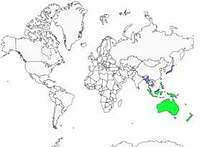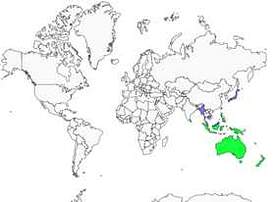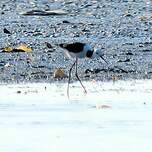Pied Stilt
Himantopus leucocephalus - Échasse d'Australie
Identification
This Pied Stilt (Himantopus himantopus) is sometimes considered to be a subspecies of the White Stilt. To a European bird watcher, it is immediately distinguishable by the length and intensity of the black band extending from the back of the neck to the base of the neck where it joins a half-ring of the same color. The back and wings are black, while the underparts, the front and sides of the neck and the rest of the head are white. The long red legs and long, thin black beak are the same on both species. The undersides of the wings are black. The immatures have white necks and heads, the crown of the head and the eye area are greyish; the juveniles are very similar in appearance to the immatures, but the feathers on the back are dark brown with light tips.
Subspecific information monotypic species
Foreign names
- Échasse d'Australie,
- Cigüeñuela Pechirroja,
- pernilongo-australasiático,
- Weißgesicht-Stelzenläufer,
- fehérfejű gólyatöcs,
- Australische Steltkluut,
- Cavaliere testabianca,
- australisk styltlöpare,
- Australstylteløper,
- šišila bielohlavá,
- Australsk Stylteløber,
- szczudłak białogłowy,
- Австралийский ходулочник,
- Gagang-bayang belang,
- オーストラリアセイタカシギ,
- 澳洲长脚鹬,
- australisk styltlöpare,
- 白頭高蹺鴴,
Voice song and call
Habitat
This monotypic species (no subspecies) breeds from Java to New Guinea, in Australia and New Zealand (naturally colonized in the 19th century) where it sometimes hybridizes with Black Stilt (Himantopus novaezelandiae) which is one of the threats to this endangered species.
Behaviour character trait
Dietfeeding habits
Reproduction nesting
Mostly, the Pied Stilt breeds in small colonies. The timing varies according to latitude and altitude.
In tropical regions, it is linked to the fall of rain. In New Zealand, plain couples begin reproduction in July, those of altitude in the South Island not before September. The nest is a large bowl of dry grasses, sometimes placed on a tuft, sometimes floating. The laying is almost always 4 eggs incubated for 3 weeks to a month by both adults. The young leave the nest within 24 hours of hatching, fly between 4 and 5 weeks later but still remain with their parents for a few months.Threats - protection
IUCN conservation status
concern
in the Wild
threatened
evaluated
The Pied Stilt of Australia is not threatened. The population of Australia, Java and New Guinea is estimated at around 300,000 individuals (but can vary greatly depending on rainfall). The population of New Zealand is around 30,000 individuals.
Sources of information
- IOC World Bird List (v15.1), Gill, F and D Donsker (Eds). 2025-12-07.
Other sources of interest
 Specification sheet created on
01/08/2023 by Georges Olioso
Specification sheet created on
01/08/2023 by Georges OliosoTranslation by AI Oiseaux.net
© 1996-2025 Oiseaux.net
- Accipitriformes
- Aegotheliformes
- Anseriformes
- Apodiformes
- Apterygiformes
- Bucerotiformes
- Caprimulgiformes
- Cariamiformes
- Casuariiformes
- Charadriiformes
- Ciconiiformes
- Coliiformes
- Columbiformes
- Coraciiformes
- Cuculiformes
- Eurypygiformes
- Falconiformes
- Galliformes
- Gaviiformes
- Gruiformes
- Leptosomiformes
- Mesitornithiformes
- Musophagiformes
- Nyctibiiformes
- Opisthocomiformes
- Otidiformes
- Passeriformes
- Pelecaniformes
- Phaethontiformes
- Phoenicopteriformes
- Piciformes
- Podargiformes
- Podicipediformes
- Procellariiformes
- Psittaciformes
- Pterocliformes
- Rheiformes
- Sphenisciformes
- Steatornithiformes
- Strigiformes
- Struthioniformes
- Suliformes
- Tinamiformes
- Trogoniformes



























